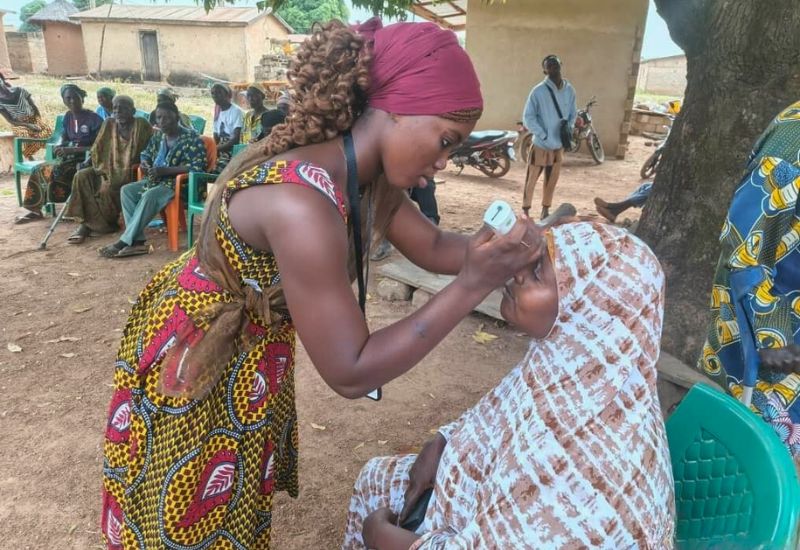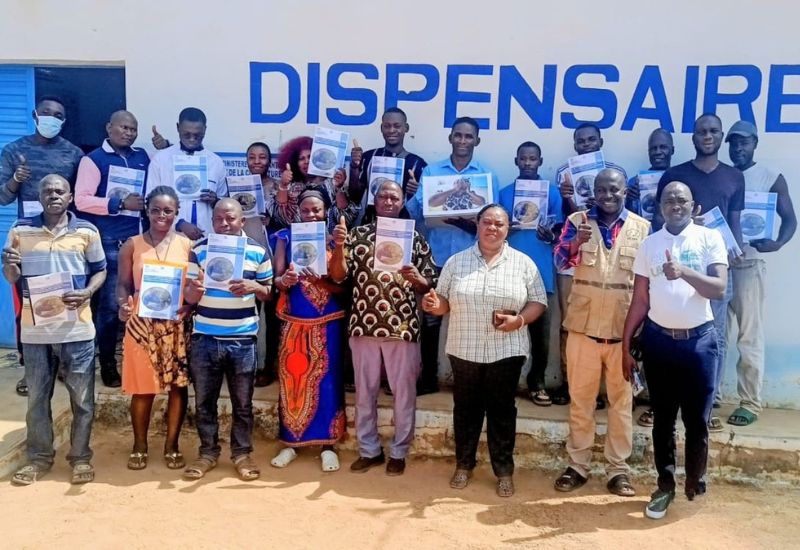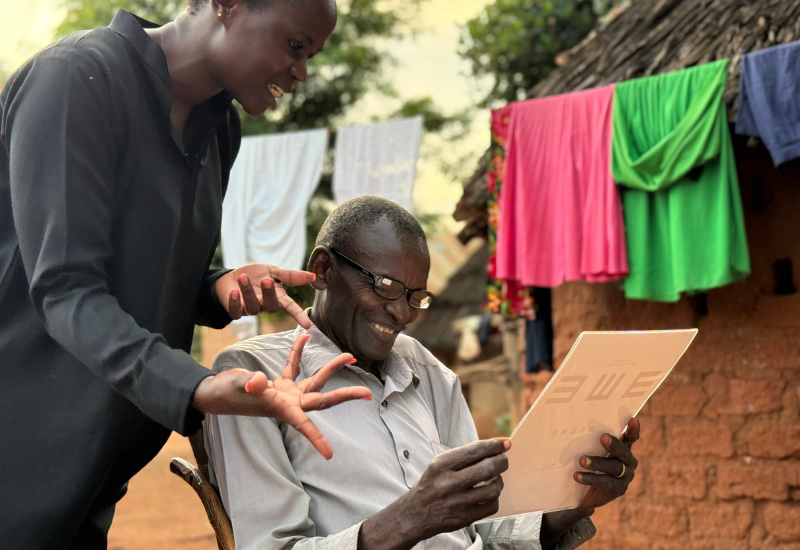Eyeglasses are a simple, affordable solution to bring clear vision, productivity, and increased quality of life to over one billion people worldwide. The Government of Liberia is leading this charge, creating routine, reliable access to eyeglasses for over 1.2 million people.
The West African nation of Liberia is one of the first in the world to include dispensing of reading glasses by government Community Health Workers (CHWs) into their national community health service package—bringing the life-changing impact of glasses to every community across the country, including the most rural and remote.
What makes Liberia’s achievement particularly significant is that it's a first-of-its-kind approach.
While models for vision screening and dispensing of reading glasses by CHWs have proven effective across diverse contexts, they have historically functioned almost exclusively outside of government health systems. Liberia’s integrated government delivery approach leverages existing investments and capacity in order to more efficiently reach and sustain national scale.

Liberia launched its community eye health pilot program in Margibi County in late 2021 with the aim of testing the integration of vision screening and provision of reading glasses within its National Community Health Program. Following the successful pilot, where 75% of adults who were screened needed glasses and were provided a pair, the Government of Liberia made the decision to include these services in its newly revised National Community Health Policy, 2023-2033. With this institutional foundation in place, Liberia is expanding these basic eye health services across the country as part of this new national community health service package.
But, what factors enabled Liberia to make this ground-breaking decision and how did EYElliance support?
Identifying and Supporting Liberia’s Decision-making Criteria
Since 2017, EYElliance has worked closely with the Liberian Ministry of Health to bring eyeglasses to the last mile. Early on, the Liberian Ministry of Health identified the priority questions and criteria for inclusion of new services under the country’s revised Community Health policy and strategy. Through the community eye health pilot, EYElliance collaborated with the government to gather the relevant evidence and insights to support inclusion in the package and scaling the program nationally. The key questions that guided decision-making are reviewed below:
1. Is it vital for mortality and morbidity reduction?
Supported by research and technical assistance provided by EYElliance, the Liberian Government considered evidence of the debilitating impacts and high prevalence of presbyopia (age-related farsightedness) and recognized that reading glasses are a simple, cost-effective solution to reduce morbidity, increase productivity, and improve quality of life.
S. Olasford Wiah, Director of the Community Health Services Division at the Liberian Ministry of Health, appreciated the impact potential of this intervention. “The eye is the light of the body.” Wiah explains, highlighting the central role of clear vision in good health and its life-changing benefits that multiply all other education, economic, and healthcare interventions.
Since the introduction of vision screening and dispensing of eyeglasses by Community Health Workers, the anticipated benefits have been validated, with thousands reaping the rewards. Beneficiaries like Musu Sumwabe (54), long-term resident of rural Kakata in Margibi County, Liberia. Musu is a seamstress, mother of seven and grandmother of eight. Musu dropped out of the workforce due to poor vision but after receiving a pair of eyeglasses she can continue to earn a living and provide for family.

2. Is this work being done already and by whom?
To answer this question, EYElliance and Liberia’s National Eye Health Program conducted a joint eye health workforce analysis. The exercise revealed significant coverage gaps and geographical disparities. At the time, the country had only six practicing ophthalmologists and one optometrist to serve a population of more than four million people; and only five out of Liberia’s 15 counties had access to even the most basic eye health services. Routine, reliable, affordable access to quality vision screening and dispensing of eyeglasses was simply not present outside of a select few hospitals and private clinics, almost all in the capital city, Monrovia.
Since then, the Ministry of Health has accelerated the expansion of the eye health workforce at the primary, secondary, and tertiary levels. However, to maximize the return on this investment and its impact on the lives of everyday Liberians, the Ministry of Health sought to extend this continuum of care to the community level and test the direct provision of basic eye screening and dispensing of reading glasses by Community Health Workers.
Worldwide more than 35,000 Community Health Workers have been successfully trained to provide these services in programs led by non-governmental organizations, and Liberia’s Ministry of Health was optimistic that similar results could be demonstrated within the context of government-led programs.
Dr. Joseph Kerkula, Program Manager of the National Eye Health Program agrees that, “This is the most effective way for us to strengthen and sustain eye care services at the community level and to reach the most-needed with reading glasses.”
3. What data and evidence exist from the Liberian context to support its inclusion?
Liberia’s government determined that a pilot program would be an ideal strategy for generating the data and evidence to validate the feasibility, effectiveness, and efficiency of having its CHWs deliver basic eye health services via the National Community Health Program. EYElliance supported the Community Health Services Division and National Eye Health Program to draw on best practices, such as the World Health Organization’s Training in Assistive Products, to inform the pilot design, execution, and integration into existing systems.
Critical amongst these systems was Liberia’s Community-Based Information System (CBIS), which collects data from existing CHW-led healthcare services. By integrating community eye health indicators into CBIS (e.g the number of individuals receiving screening, reading glasses, and referrals), the government was able to efficiently demonstrate both strong demand for services and the feasibility of reporting community eye health data alongside other services. Further integration into existing monitoring and supervision systems reinforced these findings and provided additional insights into quality of care, CHW workload, stakeholder perceptions, and other factors important for decision-making.
4. Are the required supply chain commodities and capacity available?
A key component in the Government decision making process was the availability of affordable, quality reading glasses. But, where would these eyeglasses come from and how would they move through existing systems?
EYElliance was able to facilitate access to a donation of reading glasses for the pilot and beyond. The glasses are provided by EssilorLuxottica through our partnership with the Vision Catalyst Fund. EssilorLuxottica aims to donate 200 million pairs of lenses through the Vision Catalyst Fund to partners and programmes working to enable children and adults in low-and middle-income countries to see clearly and realize their full potential. This provides a runway toward sustainability, giving the Liberian Government the confidence to scale without the pressing need to source and fund commodities.
To complement this, EYElliance supported strengthening government capacity to enable the management of reading glasses within the existing supply chain. Read more about how EYElliance supported to Integrated Eyeglasses into Liberia's Government Supply Chain here.
5. Is there funding potential?
Securing funding to scale and sustain community eye health services was essential for decision-making. EYElliance supported the Ministry of Health to track incremental costs within the pilot in order to understand the resources needed for scale up, such as vision screening materials and additional time needed for CHW training.
With this data in hand, the Ministry of Health was able to incorporate costing for community eye health within broader resource mapping and mobilization exercises for the National Community Health Program, as well as longer-term sustainable financing strategies. This approach has been critical for positioning community eye health as part of an integrated service delivery package rather than a verticalized service reliant on siloed financing.
Establishing strong institutional foundations and demonstrating how experiences within the pilot fulfill essential decision-making criteria for Liberia’s new scope of services for CHWs further solidified buy-in from Ministry of Health leaders and core external National Community Health Program funders—who will ultimately be responsible for securing the financing needed to scale and sustain the National Community Health Program, inclusive of community eye health.
Translating Evidence into Impact
Having this evidence on hand, including context-specific data and insights from the pilot, provided the Liberian Government with the evidence they needed to include vision screening and provision of reading glasses into their new National Community Health Policy, Strategy, and Service Package.
The Ministry of Health is now integrating community eye health training into the new CHW curriculum and standard operating procedures in anticipation of national scale-up in 2024. We continue to collaborate with our Ministry counterparts to develop adaptations to ensure effective and efficient national scale-up. In an upcoming blog article we will explore catalytic learnings from this approach that can enhance global momentum to pursue equitable, sustainable provision of reading glasses via government CHW programs.






.jpg)
